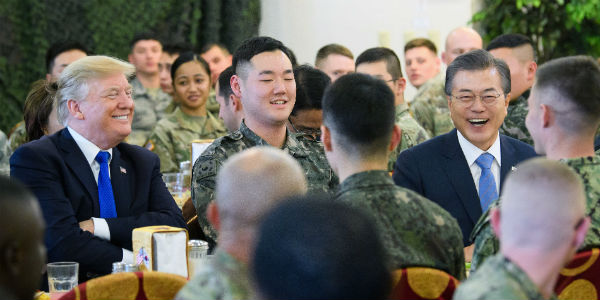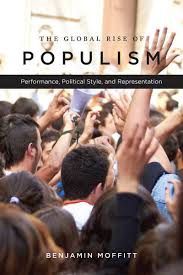Book review | The Global Rise of Populism: Performance, Political Style and Representation
In The Global Rise of Populism: Performance, Political Style and Representation, Benjamin Moffitt approaches populism as a political style that is mediated through symbols, disseminated through the mass media and performed through verbal and non-verbal modes of communication. While suggesting Moffitt’s work is more an extension of the discourse school than a radical break from it, Ben Margulies welcomes this as an important contribution to studies of populism that will enable scholars to track actors, parties and constituencies as they evolve in real time.

Donald Trump during his visit to South Korea, November 2017. Photo: Republic of Korea via a CC-BY-NC-SA 2.0 licence
The Global Rise of Populism: Performance, Political Style and Representation. Benjamin Moffitt. Stanford University Press. 2016.
Following the first anniversary of the election of Donald Trump, it may seem hard to imagine that anyone could take a fresh approach to the phenomenon of populism. Indeed, much of the key literature on the field dates back to at least the 1990s. This year is also the tenth anniversary of Cas Mudde’s major work on radical-right populism. Despite the boilerplate contentions that populism is a ‘contested’ phenomenon, we now have a fairly broad consensus about many of the key features of the ideology, actors, core constituencies and governmental habits of populism.
Benjamin Moffitt, the author of The Global Rise of Populism: Performance, Political Style and Representation, is not precisely challenging this consensus. What he is doing is proposing a new way of categorising and measuring populism, one which is both convincing and promising. By conceiving populism as a political style, Moffitt provides a powerful account of how populist identities are constructed; how style, ideology and identity interact and meld; and how populist themes and discourses can be adopted to varying degrees by different actors. Though I do not think Moffitt’s work is as radical a departure as he sometimes claims, it is nevertheless convincing and valuable.
Moffitt begins by examining ‘the four central approaches to populism’ (17). These categorise populism as an ideology (Mudde’s view); as a strategy for mobilising voters outside of institutions; as a discourse; and as a political logic (the school associated with Ernesto Laclau and Chantal Mouffe). Moffitt concludes these approaches are insufficient: Laclau’s political logic is too broad, while populism lacks the content necessary to be a real ideology. The strategy school focuses on a misleading subset of cases. Moffitt finds discourse most convincing, but thinks discourse theorists focus too exclusively on text.
Moffitt proposes instead that populism is a political style, drawing on scholars in rhetoric, political philosophy and political communications to produce his new categorisation scheme. A political style is ‘the repertoires of embodied, symbolically mediated performance made to audiences that are used to navigate the fields of power that comprise the political, stretching from the domain of government through to everyday life’ (38). He describes this as a sort of cousin to discourse theory, but his scheme includes both verbal and non-verbal forms of communication within the meaning of performance (39-40).
What is a populist ‘political style’? Moffitt assigns it three features: firstly, an appeal to ‘the People’ vs. ‘the Elite’; the demonstration of bad manners by the populist leadership – that is, a rejection of the conventions of political or even polite discourse; and the advancing of a narrative of crisis, breakdown or threat (43-45).
Moffitt spends much of the book discussing how this populist political style is a mediated one: that is, populists depend on various forms of mass media to circulate it, and media culture in turn provides the format, language, symbols and arenas for that dissemination. He convincingly discusses how the extension of ‘media logic’ – the conveying of information through a sort of dramaturgy of binary conflict, simplification, personalisation and affective appeals – has benefited populism. Populist and media styles neatly overlap (74-76). This hints at the way that populism uses media to construct political cultures, the contemporary equivalent to the unions, churches and partisan media that once made ‘social democracy’ and ‘Christian democracy’ living political and social ecologies.
Though Moffitt sees his concept of political style as a major departure in populism studies, it is striking how well it combines with the other approaches he mentions. For example, Moffitt argues that his idea of political style shows how the performance of an identity itself helps construct that identity. And that identity is not a two-dimensional grouping; in citing Frank Ankersmit and Dick Pels (35-37), he suggests that this identity and performance itself contain quite a bit of content regarding not just who the people are, but also their worldview and broadly defined political goals. Style fuses ‘matter and manner, message and package’. That is, his idea of political style can encompass and coexist with Mudde’s approach, because the style conveys a lot of the ideology.
One of the great strengths of Moffitt’s theory is that it defines populist rhetoric as a gradational phenomenon – a populist leader, and a populist party, can become more or less populist across time and space. This is of crucial importance because it reflects how populist leaders and especially parties emerge and change. Several populist parties – for instance, the Swiss People’s Party, the True Finns/Finns and Hungary’s Fidesz – began within conventional/mainstream party families and adopted a populist rhetoric and ideology over time. Other populist parties moderate their rhetoric depending on their desire to form government coalitions or alliances with mainstream parties (e.g. the Norwegian Progress Party).
Moffitt also points out that mainstream actors can adopt populist styles in response. Anyone living in Britain will have seen this at first hand as Theresa May condemned her opponents for impeding the popular will and invoked the threat of their obstruction to justify the June 2017 snap election. Takis S. Pappas theorised that populist parties can also create populist oppositions. Moffitt’s focus on style helps us understand how populist framings can infect the supposedly ‘technocratic’ mainstream, and thus alert us to threats to the overall health of the ‘liberal’ model. This also hints at changes to patterns of electoral support for political scientists and sociologists interested in investigating the social bases of the populist coalition.
I disagree with Moffitt’s contention that his concept of ‘political style’ is as distinct from ‘discourse’ as he argues. I think what Moffitt means is that it is different from forms of content analysis or ‘political discourse analysis’, which focus on text. And he is right to point out the flaws and limitations of studies that only focus on texts (which include my own) as measures of populism. But, as I understand it, ‘discourse’, generally speaking, is a mode of thought and communication that defines social roles and what counts as knowledge. Moffitt’s idea of a political style that defines and constitutes a people and implies an ideology would fit within this broader understanding of a ‘discourse’.
I am also a little skeptical of Moffitt’s decision to counterpoise his ‘populist’ style with a ‘technocratic’ one (46-47), which draws on the work of Pierre Ostiguy. I can certainly think of political contests and systems where this sort of divide functions – Ostiguy’s own Argentina, or Peru, where an aged technocrat, Pedro Pablo Kuczynski, won an election last year against an unapologetic populist, Keiko Fujimori. But how common is it for political candidates to appeal to the electorate as dry, unemotional elitists? And while calling a style ‘populist’ suggests an ideology, the label ‘technocracy’ hides the ideological commitment behind most technocratic or elitist styles, which is broadly (neo)liberal.
I would also be wary of classifying all non-populist styles as ‘technocratic’ (46). This implies that populists are the only actors who reject the status quo, or that all populists’ enemies are ideologically identical. In other words, it risks replicating the worldview populists themselves are trying to impose. Again, it may be better to use the term ‘liberal’ or ‘conventional’ to define the various discourses that are in play in the mainstream, or to specify which mainstream actor is in fact using a ‘technocratic’ style.
The Global Rise of Populism may not introduce an entirely new form of populist theory – I think it may be more accurate to define it as an extension of the discourse school. What Moffitt has done is refine discourse analysis so that it encompasses the populist phenomenon more fully, allowing us to better track populist actors and parties as they evolve in real time. His approach enables us to do this without losing sight of the ideas and worldviews that shape populism, such as its dualist way of looking at the world and its majoritarianism. He has also refocused our attention on the populist relation to the media. His work is therefore an important contribution to the practical study of populist parties, leaders and constituencies.
This post represents the views of the author and not those of Democratic Audit. It first appeared at the LSE Review of Books.
Ben Margulies is a Visiting Research Fellow at the University of Warwick. Ben’s research background is primarily in comparative and European politics, especially the quantitative analysis of trends across countries.

 Find this book:
Find this book: 



 Democratic Audit's core funding is provided by the Joseph Rowntree Charitable Trust. Additional funding is provided by the London School of Economics.
Democratic Audit's core funding is provided by the Joseph Rowntree Charitable Trust. Additional funding is provided by the London School of Economics.